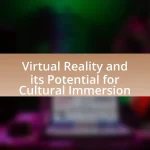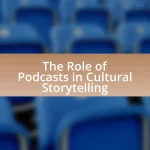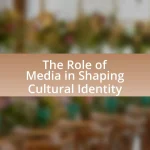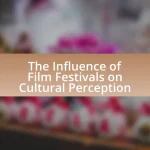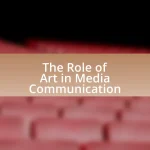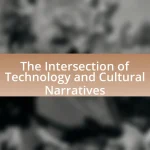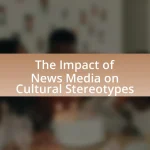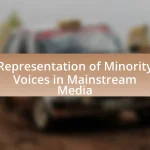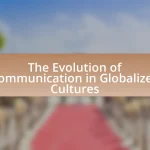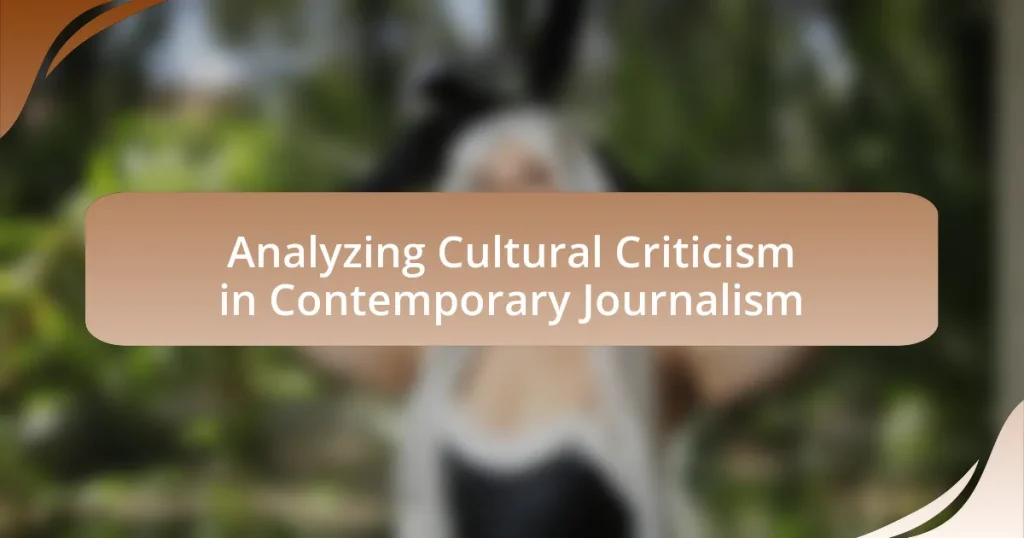Cultural criticism in contemporary journalism involves the analysis and evaluation of cultural phenomena, such as media and societal trends, through a critical lens. This article explores the evolution of cultural criticism, highlighting its shift from elitist perspectives to more inclusive viewpoints that reflect diverse societal experiences. It examines historical influences, contemporary issues, and the methodologies employed in cultural criticism, emphasizing its importance in shaping public discourse and audience perception. Additionally, the article discusses the role of technology and different media platforms in disseminating cultural critiques, along with best practices for journalists to ensure their analyses are inclusive and impactful.
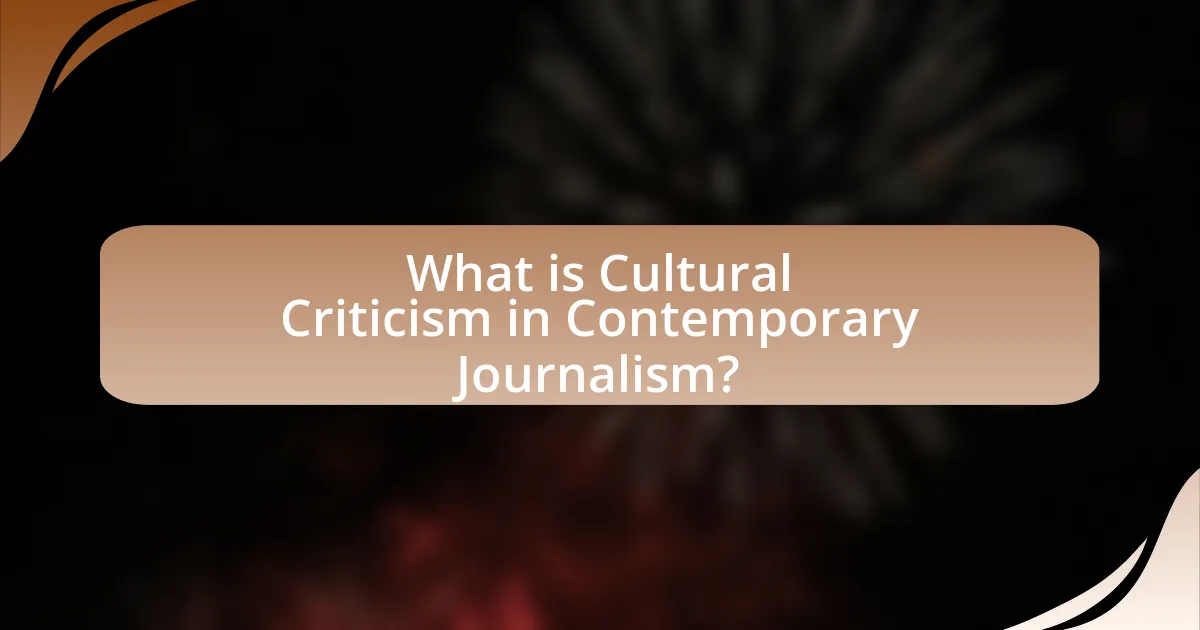
What is Cultural Criticism in Contemporary Journalism?
Cultural criticism in contemporary journalism refers to the analysis and evaluation of cultural phenomena, including media, art, and societal trends, through a critical lens. This form of criticism seeks to understand how cultural products reflect, shape, and challenge societal values and power dynamics. It often addresses issues such as representation, identity, and ideology, providing insights into the cultural context of news and media narratives. Cultural critics utilize various theoretical frameworks, including feminism, post-colonialism, and Marxism, to dissect the implications of cultural expressions and their impact on public discourse.
How has cultural criticism evolved in the context of journalism?
Cultural criticism in journalism has evolved from traditional, often elitist perspectives to more inclusive and diverse viewpoints that reflect a broader range of societal experiences. Initially, cultural criticism primarily focused on high art and literature, with critics often coming from privileged backgrounds, which limited the scope of discourse. Over time, the rise of postmodernism and the democratization of media through digital platforms have allowed for a wider array of voices and narratives to emerge, challenging established norms and hierarchies.
For instance, the advent of social media has enabled marginalized communities to share their cultural critiques directly, bypassing traditional gatekeepers in journalism. This shift is evidenced by the increasing prominence of critiques surrounding issues such as race, gender, and identity in mainstream media outlets, reflecting a more pluralistic approach to cultural commentary. Furthermore, academic frameworks, such as cultural studies, have influenced journalistic practices, encouraging journalists to engage with cultural phenomena in a more analytical and socially aware manner.
What historical factors have influenced the development of cultural criticism?
The development of cultural criticism has been influenced by several historical factors, including the rise of modernism, the impact of the Enlightenment, and the evolution of mass media. Modernism, emerging in the late 19th and early 20th centuries, challenged traditional forms of art and literature, prompting critics to explore new cultural expressions and societal norms. The Enlightenment, with its emphasis on reason and individualism, laid the groundwork for critical thought, encouraging thinkers to question established ideologies and cultural practices. Additionally, the advent of mass media in the 20th century, particularly print and later digital platforms, expanded the reach of cultural criticism, allowing diverse voices to engage with and critique cultural phenomena on a broader scale. These factors collectively shaped the landscape of cultural criticism, fostering a dynamic dialogue about culture and society.
How do contemporary issues shape cultural criticism in journalism?
Contemporary issues significantly shape cultural criticism in journalism by influencing the themes, narratives, and perspectives that journalists prioritize. For instance, the rise of social movements such as Black Lives Matter and #MeToo has prompted journalists to critically examine systemic racism and gender inequality within cultural contexts. This shift is evidenced by increased coverage of diverse voices and experiences, reflecting a broader societal demand for inclusivity and representation. Furthermore, the impact of digital media has transformed how cultural criticism is disseminated, allowing for real-time engagement and feedback from audiences, which in turn shapes ongoing discussions and critiques. This dynamic interplay between contemporary issues and cultural criticism underscores the evolving nature of journalism in response to societal changes.
Why is cultural criticism important in today’s media landscape?
Cultural criticism is important in today’s media landscape because it provides essential insights into the societal implications of media content. This form of analysis helps audiences understand how cultural narratives shape public perception and influence social norms. For instance, cultural critics often examine representations of race, gender, and class in media, revealing biases and promoting awareness of systemic issues. Research indicates that media representation can significantly affect audience attitudes and behaviors, as seen in studies like “The Impact of Media Representation on Public Perception” by Smith et al., which highlights how diverse portrayals can lead to greater acceptance and understanding among viewers. Thus, cultural criticism serves as a vital tool for fostering critical engagement with media and encouraging a more informed and equitable society.
What role does cultural criticism play in public discourse?
Cultural criticism plays a vital role in public discourse by challenging dominant narratives and fostering critical engagement with societal norms. It serves as a tool for analyzing cultural products, such as literature, film, and art, revealing underlying ideologies and power structures. For instance, cultural critics often highlight issues of representation and inequality, prompting public conversations about race, gender, and class. This engagement can lead to greater awareness and advocacy for social change, as seen in movements that have emerged from critiques of media portrayals, such as #MeToo and Black Lives Matter. By questioning accepted values and encouraging diverse perspectives, cultural criticism enriches public discourse and promotes a more informed citizenry.
How does cultural criticism impact audience perception and engagement?
Cultural criticism significantly shapes audience perception and engagement by challenging dominant narratives and encouraging critical thinking. This form of critique prompts audiences to question societal norms, values, and media representations, leading to a more informed and active engagement with cultural products. For instance, studies have shown that audiences exposed to cultural criticism are more likely to engage in discussions and seek diverse perspectives, enhancing their overall media literacy. This engagement is evidenced by increased participation in cultural dialogues and social movements, as seen in the rise of online platforms where cultural critiques are shared and debated.
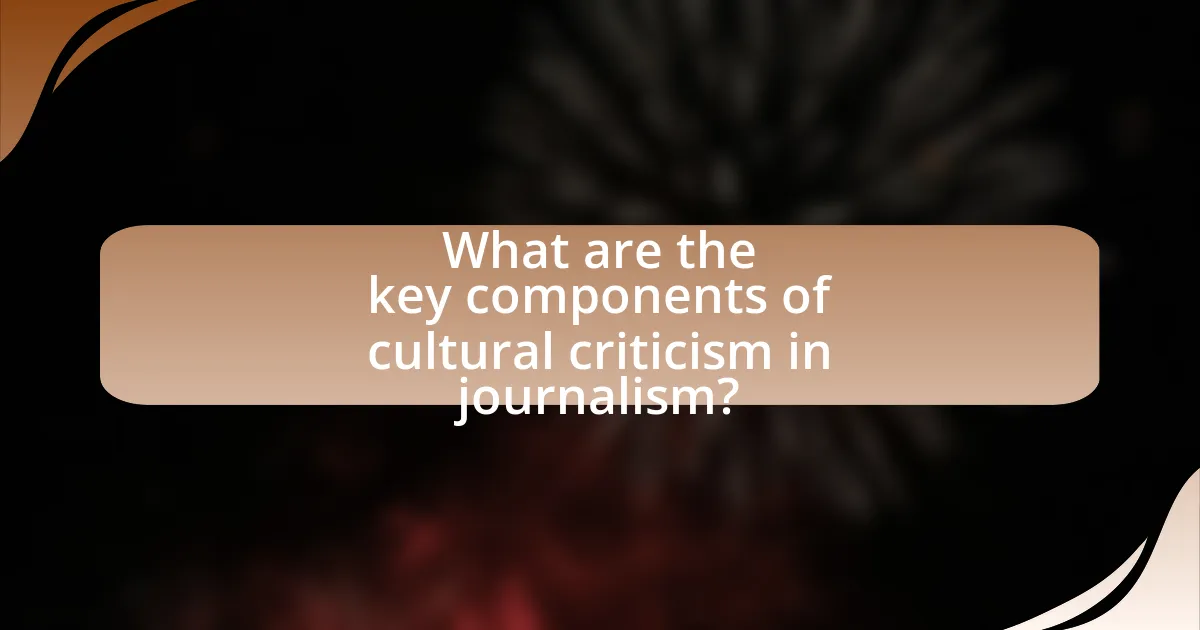
What are the key components of cultural criticism in journalism?
The key components of cultural criticism in journalism include analysis of cultural texts, examination of societal norms, and critique of power structures. Cultural criticism involves interpreting various forms of media, such as literature, film, and art, to uncover underlying messages and ideologies. It also scrutinizes how cultural products reflect or challenge societal values and beliefs, often highlighting issues related to race, gender, and class. Furthermore, cultural critics assess the influence of media on public perception and behavior, emphasizing the role of journalism in shaping cultural discourse. This approach is supported by the work of scholars like Stuart Hall, who argued that media representations play a crucial role in constructing social realities.
What methodologies are commonly used in cultural criticism?
Cultural criticism commonly employs methodologies such as textual analysis, historical contextualization, and interdisciplinary approaches. Textual analysis focuses on the close reading of cultural texts, examining language, symbols, and themes to uncover underlying meanings. Historical contextualization situates cultural artifacts within their specific socio-political and economic contexts, allowing critics to understand how historical events shape cultural production. Interdisciplinary approaches integrate insights from various fields, such as sociology, anthropology, and media studies, to provide a more comprehensive understanding of cultural phenomena. These methodologies are validated by their widespread application in academic literature, demonstrating their effectiveness in analyzing and interpreting cultural artifacts.
How do qualitative and quantitative approaches differ in cultural analysis?
Qualitative and quantitative approaches differ in cultural analysis primarily in their methodologies and objectives. Qualitative analysis focuses on understanding cultural phenomena through in-depth exploration of meanings, experiences, and contexts, often utilizing interviews, focus groups, and ethnography. In contrast, quantitative analysis emphasizes statistical measurement and numerical data to identify patterns and correlations, typically employing surveys and experiments. For instance, qualitative research might explore how individuals interpret cultural symbols, while quantitative research could measure the prevalence of those symbols across a population. This distinction is crucial as qualitative methods provide rich, contextual insights, whereas quantitative methods offer generalizable findings through statistical validation.
What are the ethical considerations in conducting cultural criticism?
Ethical considerations in conducting cultural criticism include respect for cultural diversity, accuracy in representation, and the potential impact of criticism on marginalized communities. Cultural critics must ensure that their analyses do not perpetuate stereotypes or reinforce power imbalances, as seen in historical contexts where dominant narratives overshadowed minority voices. Additionally, critics should strive for transparency regarding their own biases and motivations, as this fosters trust and accountability in their work. The ethical framework established by the Society of Professional Journalists emphasizes the importance of minimizing harm and acting with integrity, which is crucial in cultural criticism to avoid misrepresentation and to promote understanding among diverse audiences.
What themes are prevalent in contemporary cultural criticism?
Prevalent themes in contemporary cultural criticism include identity politics, globalization, and the impact of technology on society. Identity politics examines how race, gender, and sexuality shape cultural narratives and individual experiences, reflecting a growing awareness of intersectionality. Globalization critiques the cultural homogenization resulting from economic and political interconnectedness, highlighting the tension between local traditions and global influences. The impact of technology, particularly social media, is scrutinized for its role in shaping public discourse, influencing cultural consumption, and altering interpersonal relationships. These themes are supported by various scholarly works, such as bell hooks’ “Ain’t I a Woman?” which explores identity, and Arjun Appadurai’s “Modernity at Large,” which discusses globalization’s effects on culture.
How do race, gender, and class intersect in cultural criticism?
Race, gender, and class intersect in cultural criticism by shaping the perspectives and experiences that inform critiques of cultural products and practices. This intersectionality highlights how societal structures influence representation and power dynamics within cultural narratives. For instance, scholars like Kimberlé Crenshaw have emphasized that individuals experience oppression in multifaceted ways, which is evident in cultural criticism that addresses issues such as racial stereotypes, gender roles, and class disparities. Research shows that cultural critics who consider these intersecting identities can provide more nuanced analyses that reveal systemic inequalities, as seen in works that critique media portrayals of marginalized communities.
What role does technology play in shaping cultural narratives?
Technology plays a crucial role in shaping cultural narratives by facilitating the rapid dissemination and accessibility of information. Digital platforms, such as social media and online news outlets, enable diverse voices and perspectives to be shared widely, influencing public discourse and cultural understanding. For instance, the rise of social media has allowed marginalized communities to amplify their narratives, challenging traditional media representations and fostering a more inclusive cultural dialogue. Additionally, algorithms used by technology platforms can prioritize certain narratives over others, impacting which stories gain visibility and shaping societal perceptions. This dynamic interplay between technology and cultural narratives underscores the transformative power of digital communication in contemporary journalism.
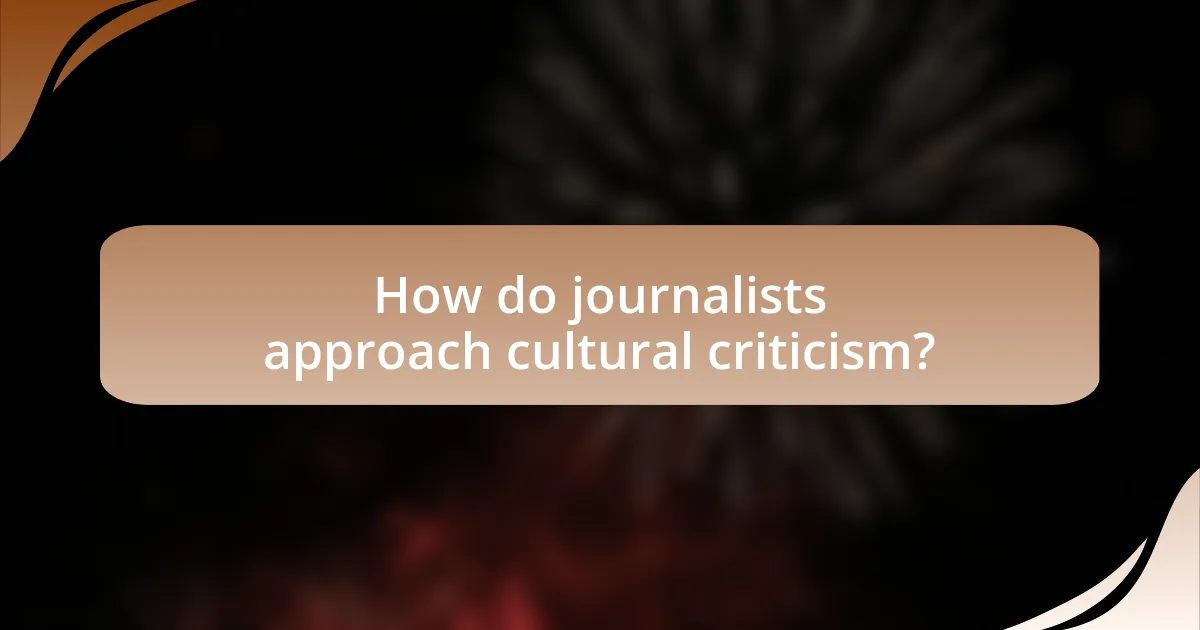
How do journalists approach cultural criticism?
Journalists approach cultural criticism by analyzing and interpreting cultural phenomena, often focusing on their societal implications. They employ various methods, including contextual analysis, comparative studies, and audience engagement, to explore how culture shapes and reflects social values. For instance, journalists may critique films, literature, or art by examining their themes, representation, and impact on public discourse. This approach is supported by the fact that cultural criticism has historically influenced public opinion and policy, as seen in the works of critics like Susan Sontag and Roland Barthes, who emphasized the role of culture in shaping identity and ideology.
What skills are essential for effective cultural criticism in journalism?
Effective cultural criticism in journalism requires strong analytical skills, cultural awareness, and clear communication abilities. Journalists must analyze cultural phenomena critically, understanding their historical and social contexts to provide insightful commentary. Cultural awareness enables journalists to navigate diverse perspectives and appreciate the nuances of different cultures, which is essential for accurate representation. Clear communication skills are vital for articulating complex ideas in an accessible manner, ensuring that the audience can engage with the critique. These skills collectively empower journalists to produce informed and impactful cultural criticism.
How can journalists develop a critical lens for cultural analysis?
Journalists can develop a critical lens for cultural analysis by engaging in continuous education and reflection on cultural contexts. This involves studying diverse cultural theories, historical perspectives, and current social issues to understand the complexities of cultural narratives. For instance, familiarity with critical theories such as postcolonialism or feminism can enhance a journalist’s ability to analyze cultural phenomena critically. Additionally, practical experience through fieldwork and interviews with various cultural stakeholders can provide insights into different viewpoints, enriching their analysis. Research indicates that journalists who actively seek out diverse perspectives and challenge their own biases produce more nuanced cultural critiques, as evidenced by studies showing that inclusive reporting leads to a deeper understanding of societal dynamics.
What are the challenges journalists face when engaging in cultural criticism?
Journalists face several challenges when engaging in cultural criticism, including the risk of backlash from audiences, the difficulty of maintaining objectivity, and the pressure to conform to prevailing cultural narratives. Backlash can manifest as public outrage or social media campaigns against the journalist, particularly when their critiques challenge deeply held beliefs or popular trends. Maintaining objectivity is challenging because personal biases can influence interpretations of cultural phenomena, leading to accusations of partiality. Additionally, journalists often feel pressured to align with dominant cultural narratives to avoid alienating audiences or losing readership, which can compromise the integrity of their criticism. These challenges highlight the complex landscape in which cultural criticism operates within contemporary journalism.
How do different media platforms influence cultural criticism?
Different media platforms significantly influence cultural criticism by shaping the accessibility, dissemination, and reception of critical perspectives. Social media platforms, for instance, allow for immediate feedback and interaction, enabling critics to engage with audiences directly and adapt their viewpoints based on public response. Traditional media, such as newspapers and television, often provide a more curated and authoritative voice, which can lend credibility to cultural critiques but may also limit diverse perspectives due to editorial constraints. Research indicates that the rise of digital platforms has democratized cultural criticism, allowing marginalized voices to emerge and challenge dominant narratives, as seen in the proliferation of blogs and independent online publications. This shift has transformed the landscape of cultural criticism, making it more inclusive and reflective of varied societal viewpoints.
What are the differences in cultural criticism between print and digital media?
Cultural criticism in print media typically emphasizes in-depth analysis and a slower, more reflective engagement with cultural texts, while digital media fosters rapid dissemination and often prioritizes immediacy and accessibility. Print media, such as magazines and journals, allows for longer-form essays that can explore complex ideas in detail, often supported by extensive research and citations. In contrast, digital platforms, including blogs and social media, encourage shorter, more concise critiques that can quickly engage a wider audience but may sacrifice depth for speed. This shift is evidenced by the rise of platforms like Medium, where cultural commentary is often brief and designed for quick consumption, contrasting with the traditional, lengthy articles found in print publications like The New Yorker.
How do social media platforms shape the dissemination of cultural criticism?
Social media platforms significantly shape the dissemination of cultural criticism by providing immediate access and broad reach to diverse audiences. These platforms enable users to share, comment on, and engage with cultural critiques in real-time, fostering a participatory culture where traditional gatekeeping is diminished. For instance, a study by Pew Research Center in 2021 found that 53% of Americans reported getting news from social media, highlighting its role as a primary source of information, including cultural commentary. Furthermore, algorithms on platforms like Twitter and Facebook prioritize content that generates engagement, often amplifying provocative cultural critiques that resonate with users, thus influencing public discourse and shaping cultural narratives.
What best practices can journalists adopt for cultural criticism?
Journalists can adopt several best practices for cultural criticism, including thorough research, contextual analysis, and diverse perspectives. Thorough research ensures that journalists understand the cultural context and nuances of the subject they are critiquing, which is essential for informed commentary. Contextual analysis allows journalists to connect cultural phenomena to broader societal issues, enhancing the depth of their critique. Additionally, incorporating diverse perspectives helps to avoid bias and enriches the discussion by representing various viewpoints, which is crucial in a multicultural society. These practices contribute to more credible and impactful cultural criticism.
How can journalists ensure their cultural criticism is inclusive and representative?
Journalists can ensure their cultural criticism is inclusive and representative by actively seeking diverse voices and perspectives in their reporting. This involves engaging with individuals from various cultural, racial, and socioeconomic backgrounds to provide a more comprehensive view of the subject matter. Research indicates that media representation significantly impacts public perception and understanding; for instance, a study by the American Press Institute found that diverse newsrooms produce more balanced and nuanced coverage. By prioritizing inclusivity in sourcing and storytelling, journalists can better reflect the complexities of cultural narratives and foster a more equitable discourse.
What strategies can enhance the impact of cultural criticism in journalism?
To enhance the impact of cultural criticism in journalism, journalists should employ interdisciplinary approaches, engage diverse voices, and utilize digital platforms effectively. Interdisciplinary approaches allow for a richer analysis by integrating insights from sociology, history, and art, which can deepen the understanding of cultural phenomena. Engaging diverse voices ensures representation and broadens perspectives, making cultural criticism more relatable and impactful. Utilizing digital platforms, such as social media and multimedia storytelling, increases accessibility and audience reach, allowing for immediate feedback and interaction, which can amplify the discourse surrounding cultural issues. These strategies collectively strengthen the relevance and resonance of cultural criticism in contemporary journalism.
